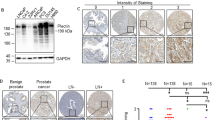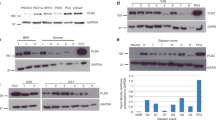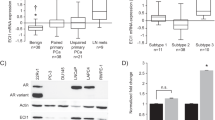Abstract
The most ominous development in tumor progression is the transition to an invasive and metastatic phenotype. Little is known, however, about the molecular alterations that cause a tumor to become invasive. In view of this, we have used microarray expression analysis to evaluate the expression profiles of a unique panel of human DU145 prostate cancer sublines that vary in their invasive potential. The three DU145 sublines expressed epidermal growth factor (EGF) receptors that differed in their ability to activate phospholipase C-γ (PLCγ). Three-way analyses yielded 11 genes out of 4608 genes screened that associated directly or inversely with invasive potential. The gene whose expression correlated most strongly with lack of invasion was identified as a potential invasion suppressor and called prostin-1. Pharmacological inhibition of PLCγ (U73122) confirmed that PLCγ signaling suppressed prostin-1 in that U73122 treatment caused induction of prostin-1 in PLCγ competent cells. The prostin-1 gene, conserved through phylogeny, is induced by androgen in LNCaP cells and encodes a 92 amino acid protein. The protein shares no extensive homologies with other known genes, yet was recently identified as a small stabilizer subunit of the dolichol-phosphate-mannose (DPM) synthase complex. That DPM3/prostin-1 might suppress tumor progression was supported by the finding that exogenous expression in COS cells leads to apoptosis. These findings support the use of model cell lines to identify putative tumor suppressors and promoters.
This is a preview of subscription content, access via your institution
Access options
Subscribe to this journal
Receive 50 print issues and online access
$259.00 per year
only $5.18 per issue
Buy this article
- Purchase on Springer Link
- Instant access to full article PDF
Prices may be subject to local taxes which are calculated during checkout







Similar content being viewed by others
References
Altschul SF, Gish W, Miller W, Myers WE, Lipman DJ . 1990 J. Mol. Biol. 215: 403–410
Altschul SF, Madden TL, Schaffer AA, Zhang J, Zhang Z, Miller W, Lipman DJ . 1997 Nucleic Acids Res. 25: 3389–3402
Andreasen PA, Kjoller L, Christensen L, Duffy MJ . 1997 Int. J. Cancer 72: 1–22
Barrack ER . 1997 Prostate 31: 61–70
Bauer J, Margolis M, Schreiner C, Edgell CJ, Azizkhan J, Lazarowski E, Juliano RL . 1992 J. Cell. Physiol. 153: 437–449
Bornfeldt KE, Raines EW, Graves LM, Skinner MP, Krebs EG, Ross R . 1995 Ann. NY Acad. Sci. 766: 416–430
Boros P, Miller CM . 1995 Lancet 345: 293–295
Chen P, Gupta K, Wells A . 1994a J. Cell. Biol. 124: 547–555
Chen P, Xie H, Sekar MC, Gupta K, Wells A . 1994b J. Cell. Biol. 127: 847–857
Chen P, Xie H, Wells A . 1996 Mol. Biol. Cell 7: 871–881
David M, Wong L, Flavell R, Thompson SA, Wells A, Larner AC, Johnson GR . 1996 J. Biol. Chem. 271: 9185–9188
Glading A, Chang P, Lauffenburger DA, Wells A . 2000 J. Biol. Chem. 275: 2390–2398
Gordon SR, Staley CA . 1990 Cell. Motil. Cytoskeleton 16: 47–57
Heller RA, Schena M, Chai A, Shalon D, Bedilion T, Gilmore J, Woolley DE, Davis RW . 1997 Proc. Natl. Acad. Sci. USA 94: 2150–2155
Jacobs W, Mikkelsen T, Smith R, Nelson K, Rosenblum ML, Kohn EC . 1997 J. Neurooncol. 32: 93–101
Kameyama T, Murakami Y, Suto F, Kawakami A, Takagi S, Hirata T, Fujisawa H . 1996 Biochem. Biophys. Res. Commun. 226: 396–402
Karpf AR, Peterson PW, Rawlins JT, Dalley BK, Yang Q, Albertsen H, Jones DA . 1999 Proc. Natl. Acad. Sci. USA 96: 14007–14012
Kim HG, Kassis J, Souto JC, Turner T, Wells A . 1999 Histol. Histopathol. 14: 1175–1182
Kundra V, Escobedo JA, Kazlauskas A, Kim HK, Rhee SG, Williams LT, Zetter BR . 1994a Nature 367: 474–476
Kindra V, Soker S, Zetter BR . 1994b Oncogene 9: 1429–1435
Kustikova O, Kramerov D, Grigorian M, Berezin V, Bock E, Lukanidin E, Tulchinsky E . 1998 Mol. Cell. Biol. 18: 7095–7105
Lal A, Lash AE, Altschul SF, Velculescu V, Zhang L, McLendon RE, Marra MA, Prange C, Morin PJ, Polyak K, Papadopoulos N, Vogelstein B, Kinzler KW, Strausberg RL, Riggins GJ . 1999 Cancer Res. 59: 5403–5407
Lauffenburger DA, Horwitz AF . 1996 Cell 84: 359–369
Maeda Y, Tanaka S, Hino J, Kangawa K, Kinoshita T . 2000 EMBO J. 19: 2475–2482
Maheshwari G, Wells A, Griffith LG, Lauffenburger DA . 1999 Biophys. J. 76: 2814–2823
Malliri A, Symons M, Hennigan RF, Hurlstone AF, Lamb RF, Wheeler T, Ozanne BW . 1998 J. Cell. Biol. 143: 1087–1099
Mettlin C, Jones GW, Murphy GP . 1993 CA Cancer J. Clin. 43: 83–91
Moul JW . 1996 Fed. Pract. 13: 3–8
Nguyen DH, Hussaini IM, Gonias SL . 1998 J. Biol. Chem. 273: 8502–8507
Reuning U, Magdolen V, Wilhelm O, Fischer K, Lutz V, Graeff H, Schmitt M . 1998 Int. J. Oncol. 13: 893–906
Rochefort H. Platet N, Hayashido Y, Derocq D, Lucas A, Cunat S, Garcia M . 1998 J. Steroid. Biochem. Mol. Biol. 65: 163–168
Schena M, Shalon D, Davis RW, Brown PO . 1995 Science 270: 467–470
Schena M, Shalon D, Heller R, Chai A, Brown PO, Davis RW . 1996 Proc. Natl. Acad. Sci. USA 93: 10614–10619
Schmitt M, Wilhelm O, Janicke F, Magdolen V, Reuning U, Ohi H, Moniwa N, Kobayashi H, Weidle U, Graeff H . 1995 J. Obstet. Gynaecol. 21: 151–165
Shultz MJ . 1996 Fed. Pract. 13: 14–18
Stossel TP . 1993 Science 260: 1086–1094
Takaoka A, Hinoda Y, Satoh S, Adachi Y, Itoh F, Adachi M, Imai K . 1998 Oncogene 16: 1443–1453
Turner T, Chen P, Goodly LJ, Wells A . 1996 Clin. Exp. Metastasis 14: 409–418
Turner T, Epps-Fung MV, Kassis J, Wells A . 1997 Clin. Cancer Res. 3: 2275–2282
Velculescu VE, Zhang L, Vogelstein B, Kinzler KW . 1995 Science 270: 484–487
Ware MF, Wells A, Lauffenburger DA . 1998 J. Cell. Sci. 111: 2423–2432
Wells A, Gupta K, Chang P, Swindle S, Glading A, Shiraha H . 1998 Microsc. Res. Tech. 43: 395–411
Wennstrom S, Siegbahn A, Yokote K, Arvidsson AK, Heldin CH, Mori A, Claesson-Welsh L . 1994 Oncogene 9: 651–660
Whittemore AS, Keller JB, Betensky R . 1991 J. Natl. Cancer Inst. 83: 1231–1235
Winberg ML, Noordermeer JN, Tamagnone L, Comoglio PM, Spriggs MK, Tessier-Lavigne M, Goodman CS . 1998 Cell 95: 903–916
Xie H, Turner T, Wang MH, Singh RK, Siegal GP, Wells A . 1995 Clin. Exp. Metastasis 13: 407–419
Zhang L, Zhou W, Velculescu VE, Kern SE, Hruban RH, Hamilton SR, Vogelstein B, Kinzler KW . 1997 Science 276: 1268–1272
Author information
Authors and Affiliations
Rights and permissions
About this article
Cite this article
Manos, E., Kim, MH., Kassis, J. et al. Dolichol-phosphate-mannose-3 (DPM3)/prostin-1 is a novel phospholipase C-γ regulated gene negatively associated with prostate tumor invasion. Oncogene 20, 2781–2790 (2001). https://doi.org/10.1038/sj.onc.1204379
Received:
Revised:
Accepted:
Issue Date:
DOI: https://doi.org/10.1038/sj.onc.1204379
Keywords
This article is cited by
-
Phospholipase Cγ1 regulates the Rap GEF1-Rap1 signalling axis in the control of human prostate carcinoma cell adhesion
Oncogene (2008)
-
A reciprocal tensin-3–cten switch mediates EGF-driven mammary cell migration
Nature Cell Biology (2007)
-
STAT3 is required but not sufficient for EGF receptor-mediated migration and invasion of human prostate carcinoma cell lines
British Journal of Cancer (2006)



